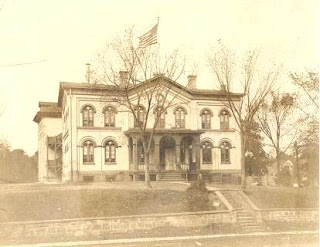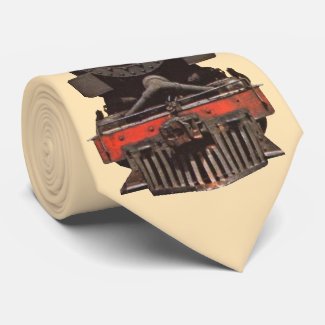Belleville High School
Belleville, New Jersey
The 4 High Schools
 The Academy, located on the grounds where School 1 is today, is the historic beginning of learning in Belleville.
The Academy, located on the grounds where School 1 is today, is the historic beginning of learning in Belleville.
The 4 High Schools
No, that's not the name of a DooWop group, it is how many high schools there have been since the beginning of Belleville's high school program. To find the first, we must reach back from our vantage point in this 21st Century, entirely through the 20th to the closing decade of the 19th Century when, in 1896, we find our village's first advanced learning curriculum, the first acknowledgement that more than rudimentary education might be needed by young people to get on in the world. It was slow getting started. Public education at any level began not much earlier.
It was in the middle of the nineteenth century when attitudes toward education were changing such that sentiments leaned more and more toward thinking it a public responsibility to prepare young people for life with advanced learning. The concept was not entirely new as our village, along with our sister Dutch colonies, had been first in the New World, as early as the late 17 Century, to ensure the education of all children in a tax funded school system. Our public school system, however, ended abruptly when the English invaders became the new masters of the colonies. Free, tax funded education was not an English custom. It was abolished. The Dutch church assumed the responsibility of educating the young, but unable to collect taxes to that end, the system was funded by subscription, thus it was no longer free to young scholars.
Modern parents of the mid nineteenth century, a generation steeped in Victorian sensibilities, having seen the consequences of 150 years and so many generations of under-educated children, were demanding a return to a tax funded system to ensure at least a rudimentary education for all children. Belleville responded in 1853. In that year, a public school furnishing six grades of elementary education was established.
High school was not yet a part of the new system. High school was a noble concept existing in only a few places. In those days, students went to grammar school through six grades. This was considered a complete elementary education. The young scholar knew how to read, write, do basic math and had been introduced to the "logic" of geometry. Education beyond that level was considered excessive. A young boy could then begin his apprenticeship at work and a young girl her apprenticeship in the kitchen.
For those with higher educational expectations, after grammar school, there was prep school to bridge the gap between elementary school and college. Trouble was, prep schools were private schools, expensive and available only to well-to-do families. In a world of exploding industrial achievements, it became clear to worried parents who wanted a higher standing for their children than was their own in industrialized society, that something more must be provided in the public school system. The eventual addition of 7th and 8th grades did help to bridge the gap in the public system, cutting down on the time needed in prep school. Still, public schools did not make the young scholar ready for college until finally, there was the addition of the public high school program. At first, in Belleville, high school was a two-year program, but it was not long before a full four-year curriculum was in place and students could be "prepped" for college, trade school or the military in our village public system.
It was in the middle of the nineteenth century when attitudes toward education were changing such that sentiments leaned more and more toward thinking it a public responsibility to prepare young people for life with advanced learning. The concept was not entirely new as our village, along with our sister Dutch colonies, had been first in the New World, as early as the late 17 Century, to ensure the education of all children in a tax funded school system. Our public school system, however, ended abruptly when the English invaders became the new masters of the colonies. Free, tax funded education was not an English custom. It was abolished. The Dutch church assumed the responsibility of educating the young, but unable to collect taxes to that end, the system was funded by subscription, thus it was no longer free to young scholars.
Modern parents of the mid nineteenth century, a generation steeped in Victorian sensibilities, having seen the consequences of 150 years and so many generations of under-educated children, were demanding a return to a tax funded system to ensure at least a rudimentary education for all children. Belleville responded in 1853. In that year, a public school furnishing six grades of elementary education was established.
High school was not yet a part of the new system. High school was a noble concept existing in only a few places. In those days, students went to grammar school through six grades. This was considered a complete elementary education. The young scholar knew how to read, write, do basic math and had been introduced to the "logic" of geometry. Education beyond that level was considered excessive. A young boy could then begin his apprenticeship at work and a young girl her apprenticeship in the kitchen.
For those with higher educational expectations, after grammar school, there was prep school to bridge the gap between elementary school and college. Trouble was, prep schools were private schools, expensive and available only to well-to-do families. In a world of exploding industrial achievements, it became clear to worried parents who wanted a higher standing for their children than was their own in industrialized society, that something more must be provided in the public school system. The eventual addition of 7th and 8th grades did help to bridge the gap in the public system, cutting down on the time needed in prep school. Still, public schools did not make the young scholar ready for college until finally, there was the addition of the public high school program. At first, in Belleville, high school was a two-year program, but it was not long before a full four-year curriculum was in place and students could be "prepped" for college, trade school or the military in our village public system.
The "Academy", built in 1853, was Belleville's first public school. Later, it was enlarged and re-named School 1. The old, original Academy, now behind and dwarfed by School 1, became our first high school in 1896. Lacking anything remotely resembling modern amenities, it was a challenge to study there, but Belleville's scholars were a hardy lot and they made do.
The situation improved, but only a little, when the high school program was relocated, in 1903, to the newer School 3 built in 1897. Many old photos and period postcards identify School 3 as "Belleville High School". Well, .. that was partly true. School 3 was a multi-purpose school. It housed a complete elementary school system, including grades 7 and 8. The high school program occupied the third floor, so to that extent, School 3 was the high school and remained so until 1915.
1915 was a year which underscored the importance of the high school program. It was then that the Washington Avenue building was completed. It was the first building used exclusively by the rapidly growing high school program. In that sense, the Washington Avenue school was the first high school; that is, the first building dedicated to only the high school program.
The situation improved, but only a little, when the high school program was relocated, in 1903, to the newer School 3 built in 1897. Many old photos and period postcards identify School 3 as "Belleville High School". Well, .. that was partly true. School 3 was a multi-purpose school. It housed a complete elementary school system, including grades 7 and 8. The high school program occupied the third floor, so to that extent, School 3 was the high school and remained so until 1915.
1915 was a year which underscored the importance of the high school program. It was then that the Washington Avenue building was completed. It was the first building used exclusively by the rapidly growing high school program. In that sense, the Washington Avenue school was the first high school; that is, the first building dedicated to only the high school program.
The original building was designed by famed Belleville architect Charles Granville Jones. It was a royal beauty. Several photos of the original building still exist. There were three additions to the school. No photos of the intermediate stages have surfaced so far. The final addition completed in 1937, including the gymnasium, is the way we see the building today. The Washington Avenue school, School 6 according to the town numbering system, served the community for 50 years as a high school and serves the community still as a middle school. It is well cared for, looks really spiffy with all new windows and is now surrounded with Cherry Blossom trees.
The new high school, our fourth high school, situated on campus-like grounds adjacent to the stadium, is pleasant enough. Although we call it the "new" school, if the truth is to be told, it is 45 years old now. Your author-here-present, having taken various adult school courses, once trying desperately to learn Italian before a trip to Rome, has thus been a student in the new school. It is reasonably comfortable, but lacks the classic charm and character of the Washington Avenue school. Perhaps I am prejudiced, after all, I graduated from the Washington Avenue school.
The new high school, our fourth high school, situated on campus-like grounds adjacent to the stadium, is pleasant enough. Although we call it the "new" school, if the truth is to be told, it is 45 years old now. Your author-here-present, having taken various adult school courses, once trying desperately to learn Italian before a trip to Rome, has thus been a student in the new school. It is reasonably comfortable, but lacks the classic charm and character of the Washington Avenue school. Perhaps I am prejudiced, after all, I graduated from the Washington Avenue school.
 The Academy, located on the grounds where School 1 is today, is the historic beginning of learning in Belleville.
The Academy, located on the grounds where School 1 is today, is the historic beginning of learning in Belleville.

































